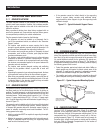
24
Figure 2.6 – Types of Lock Seams
After the compartment has been metal lined and vapor •
sealed, line the compartment interior walls and ceiling with an
approved, nonflammable sound insulating material (see "Sound
Insulating Materials").
Do not install any flammable material directly
above or around the compartment. Heat,
transferred through the compartment struc-
ture, may be sufficient to ignite, char or dis-
color seat cushions, fiberboard and other
flammable materials. Use approved nonflam-
mable insulating materials in high tempera-
ture areas.
2.2.3 SOUND INSULATING MATERIALS
Once installers have determined that a compartment is properly
constructed and metal lined, they can add acoustical material.
This may include additional sealant or insulating material, to reflect
noise away from the vehicle interior.
Sound insulating materials should be of a nonflammable type. One
excellent insulating material is a 1-inch (25 mm) thick fiberglass
having a 2-pound density. When fiberglass is used, its coated side
should face toward the compartment interior.
Do not install sound insulation or any absor-
bent material on the compartment floor inte-
rior. Such materials will become soaked with
combustible or explosive vapors and
liquids and will become a fire hazard.
Using a combination of sound insulating materials can often
reduce noise more effectively than a single material. For example,
a sheet of lead or visco-elastic material, along with a layer of other
acoustical material, is more effective than when a single material
is used.
2.2.4 ACOUSTICS
For additional noise abatement, the installer may wish to consider
the following:
Using special sound insulating materials.•
Construction of a special noise abatement compartment.•
NOTE:
Any method used to reduce noise must not adversely affect the
flow of cooling and ventilating air into or out of the compart-
ment.
In addition to the effective use of sound insulating materials,
construction of a special noise abatement compartment might be
considered to reduce noise levels. Such a compartment might be
constructed as follows (Figure 2.7):
Use 5/8-inch thick or 3/4-inch thick plywood in the compart-•
ment.
Construct the compartment floor of a double thickness of 5/8-•
inch or 3/4-inch plywood.
Figure 2.7 – Typical Noise Abatement
Line the compartment interior walls and floor, as well as the •
underside of the floor, with 26-gauge galvanized steel.
Vapor seal all compartment seams and joints.•
Over the galvanized steel lining, install a combination of acousti-•
cal materials as mentioned in "Sound Insulating Materials".
To prevent fire or explosion, do not install
any insulation or other absorbent materials
on the interior or underside of the compart-
ment floor.
Seal all compartment door edges to prevent noise leakage •
around the door perimeter.
Line the compartment door interior (except for air openings) •
with suitable, fireproof sound insulation (such as 1-inch (25
mm) thick fiberglass with a 2-pound density).
2.2.5 COMPARTMENT FLOOR CUTOUTS
Provide openings in the generator compartment for the following
items (Figure 2.8 on page 26):
Engine exhaust and cooling air outlets•
Generator cooling air inlet•
Four holes for passage of generator mounting bolts (see •
"Generator Restraint").
Installation


















